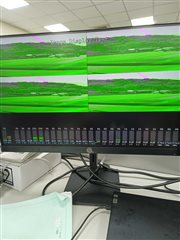Hi experts,
I'm trying to display multiple images, using mosaicnode + displaynode.
I create 4 vx_image, then use vxCreateObjectArray to convert them into array, then set into mosaicnode.
However, I failed to display images while running the graph.
The images seemed to be all green.
Is there any error in how I implement this? this is the create_graph I implemented.
Thanks.
static vx_status app_create_graph(AppObj *obj)
{
vx_status status = VX_SUCCESS;
vx_graph_parameter_queue_params_t graph_parameters_queue_params_list[2] = {0};
vx_int32 graph_parameter_index;
obj->graph = vxCreateGraph(obj->context);
status = vxGetStatus((vx_reference)obj->graph);
if (status == VX_SUCCESS)
{
status = vxSetReferenceName((vx_reference)obj->graph, "app_multi_cam_graph");
APP_PRINTF("Graph create done!\n");
}
vx_int32 idx = 0;
obj->mosaic_in_arr1 = vxCreateObjectArray(obj->context, (vx_reference)obj->display_image1, 1);
obj->mosaic_in_arr2 = vxCreateObjectArray(obj->context, (vx_reference)obj->display_image2, 1);
obj->mosaic_in_arr3 = vxCreateObjectArray(obj->context, (vx_reference)obj->display_image3, 1);
obj->mosaic_in_arr4 = vxCreateObjectArray(obj->context, (vx_reference)obj->display_image4, 1);
obj->imgMosaicObj.input_arr[0] = obj->mosaic_in_arr1;
obj->imgMosaicObj.input_arr[1] = obj->mosaic_in_arr2;
obj->imgMosaicObj.input_arr[2] = obj->mosaic_in_arr3;
obj->imgMosaicObj.input_arr[3] = obj->mosaic_in_arr4;
obj->imgMosaicObj.num_inputs = 4;
vx_image display_in_image;
status = app_create_graph_img_mosaic(obj->graph, &obj->imgMosaicObj, NULL);
APP_PRINTF("Img Mosaic graph done!\n");
display_in_image = obj->imgMosaicObj.output_image[0];
if(status == VX_SUCCESS)
{
status = app_create_graph_display1(obj->graph, &obj->displayObj, display_in_image);
APP_PRINTF("Display graph done!\n");
}
if(status == VX_SUCCESS)
{
status = vxVerifyGraph(obj->graph);
}
return status;
}


